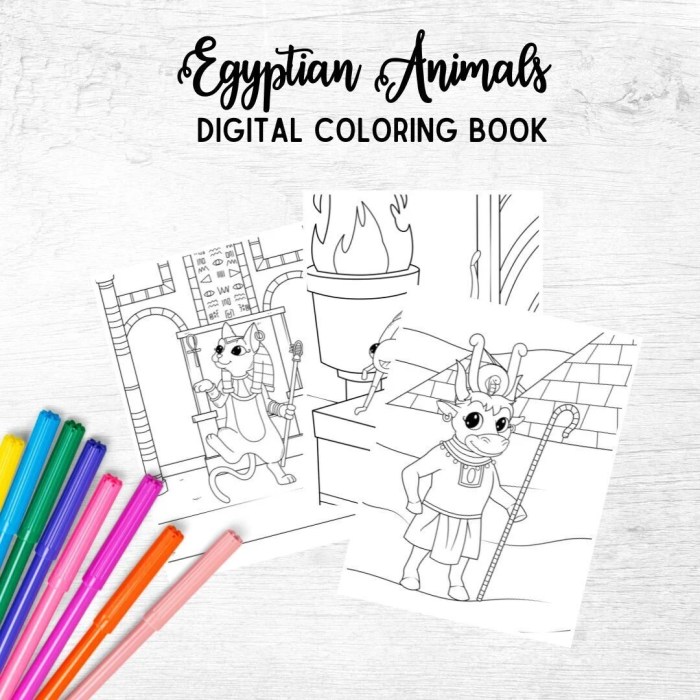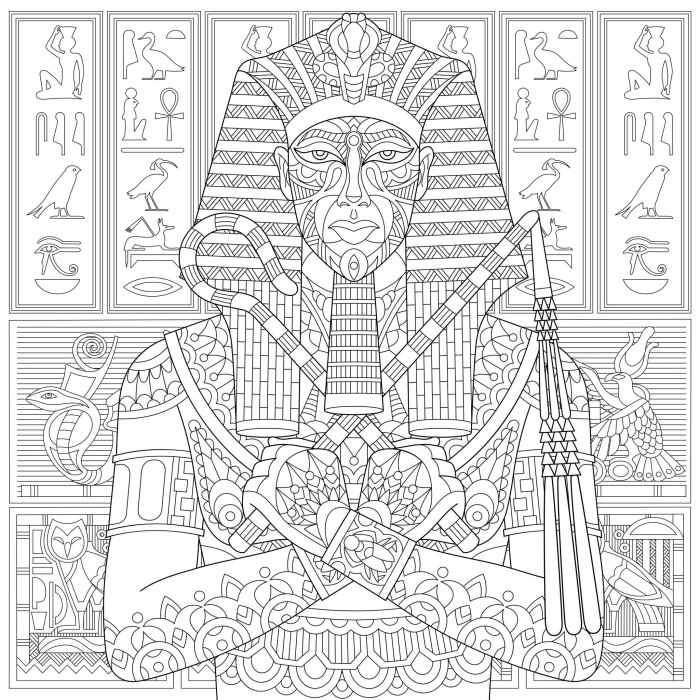Ancient Egyptian Art Styles in Coloring Pages

Anim egyptian coloring pages – Ancient Egyptian art, with its distinctive conventions and symbolism, offers a rich source of inspiration for creating engaging and educational coloring pages for children. The simplified representation of complex artistic elements allows for both creative expression and learning about a fascinating culture. This exploration will detail the common artistic features suitable for coloring pages, highlight stylistic differences across various periods, and provide examples of how to adapt these features for a child-friendly format.
Common Artistic Conventions in Ancient Egyptian Art
Ancient Egyptian art employed specific conventions that lend themselves well to coloring pages. The most notable is the use of profile views for figures, where the head, shoulders, and legs are shown in profile, while the eye and torso are presented frontally. Hieroglyphs, the ancient Egyptian writing system, are also frequently depicted in art and can be incorporated into coloring pages, providing a visual and educational element.
Symbolic colors played a significant role, with specific colors representing deities, concepts, or social status. For instance, gold often represented divinity, while blue represented the sky and water. These symbolic aspects can be highlighted through color choices in the coloring pages.
Stylistic Differences Across Artistic Periods
While consistent conventions existed throughout Egyptian art history, stylistic variations occurred across different periods. The Old Kingdom (c. 2686-2181 BCE), known for its monumental architecture, featured a more rigid and formal style in its art. Figures are often depicted with a sense of grandeur and stability, emphasizing power and order. In coloring pages, this could be represented by bold Artikels, clear lines of symmetry, and a limited palette of strong, solid colors.
In contrast, the New Kingdom (c. 1550-1070 BCE) saw a greater degree of naturalism and movement in art. Figures become more dynamic, with more attention to detail and emotional expression. Color palettes become more varied and nuanced, reflecting a richer artistic sensibility. Coloring pages reflecting this period could show more fluid lines, varied poses, and a broader range of colors.
Simplifying Distinctive Features for Children
Adapting the complexity of ancient Egyptian art for children’s coloring pages requires simplification. Proportions can be adjusted to be more child-friendly, avoiding overly elongated limbs or disproportionate features. Lines can be thickened to make them easier to follow, and intricate details can be omitted or simplified. The use of bold, clear Artikels will aid children in coloring within the lines and understanding the basic forms.
Complex scenes can be broken down into simpler components, making the task less daunting. The symbolic use of color should be simplified to a basic level, allowing children to explore color associations and their significance.
Coloring Page Layouts
| Layout 1: Old Kingdom Pharaoh A simplified depiction of a pharaoh in a profile view, wearing a nemes headdress and holding a crook and flail. The background could feature simple hieroglyphs and a stylized landscape in muted earth tones. The pharaoh would be rendered with bold, solid colors. |
Layout 2: New Kingdom Scene A scene depicting people engaged in everyday activities, such as farming or crafting. Figures would be shown in profile but with more dynamic poses and varied facial expressions. The color palette would be more diverse, including brighter and more varied hues. Simple hieroglyphs could be incorporated into the scene as labels or decorative elements. |
| Layout 3: Symbolic Animal A coloring page featuring a symbolic animal, such as a scarab beetle or a falcon, both important in ancient Egyptian religion. The animal would be depicted in a simplified, stylized manner, with clear Artikels and a limited color palette, focusing on the animal’s symbolic colors and attributes. |
Everyday Life in Ancient Egypt for Coloring Pages: Anim Egyptian Coloring Pages

Ancient Egypt, a civilization renowned for its majestic pyramids and powerful pharaohs, also possessed a vibrant and complex daily life. This section explores the everyday activities of the Egyptian people, offering detailed descriptions and illustrative scenes perfect for coloring pages, bringing the past to life with color and imagination. These scenes will depict the tools, clothing, and architecture characteristic of this fascinating era.
Farming Scenes in Ancient Egypt
Farming was the backbone of Ancient Egyptian society. The annual flooding of the Nile River provided fertile land for agriculture. Coloring pages could depict farmers tilling the land with plows pulled by oxen, sowing seeds, harvesting crops like wheat and barley, and irrigating fields using canals and shadufs (a type of lever-operated water lifting device). Farmers often wore simple linen garments – loose-fitting robes and head coverings to protect from the sun.
Tools included wooden plows, sickles for harvesting, and baskets for carrying produce. The fertile fields, bordered by canals and dotted with hardworking farmers, would make a vibrant coloring page.
Fishing on the Nile
The Nile River was a vital source of food and transportation. A coloring page could showcase fishermen casting nets, using harpoons, or employing ingenious traps to catch fish. Fishermen typically wore minimal clothing, perhaps a loincloth, and used simple tools made of wood, reeds, and possibly bone. Their boats, often made of papyrus reeds, would add an interesting element to the scene.
The shimmering water of the Nile, reflecting the sun, would be a beautiful backdrop for the fishermen and their catch.
Pyramid Construction
Building the pyramids was a massive undertaking requiring the coordinated efforts of thousands of workers. A coloring page could illustrate this process, showing workers hauling massive stone blocks using ramps and levers, skilled masons shaping and fitting the stones, and supervisors overseeing the project. Workers wore simple linen clothing, and their tools included levers, rollers, ropes, and chisels made of copper or stone.
The grandeur of the pyramid itself, partially constructed, would make a powerful visual statement. The scene would also include overseers, dressed in slightly more elaborate clothing, perhaps indicating their higher social standing.
Bustling Marketplace Scene, Anim egyptian coloring pages
Ancient Egyptian marketplaces were vibrant hubs of activity. A coloring page depicting a bustling marketplace would showcase a diverse range of characters and goods. Merchants selling pottery, textiles, jewelry, and food would be central figures, along with buyers haggling over prices. The architecture would include simple stalls and perhaps a larger building serving as a central marketplace. Clothing would vary depending on social status and occupation; some might wear elaborate jewelry and fine linen, while others would have simpler attire.
Animals, such as donkeys carrying goods, would add to the lively atmosphere. The diverse range of goods – from intricately designed pottery to vibrant textiles – would offer a rich palette of colors for the artist. The scene could also include scribes recording transactions, adding another layer of complexity and detail.
Table of Daily Life Scenes
| Farming | Fishing | Pyramid Construction | Marketplace |
|---|---|---|---|
| Farmers tilling land with oxen, sowing seeds, harvesting crops. Simple linen clothing, wooden plows, sickles, baskets. | Fishermen casting nets, using harpoons, or traps. Minimal clothing, wooden tools, papyrus reed boats. | Workers hauling stone blocks using ramps and levers, masons shaping stones. Simple linen clothing, levers, rollers, ropes, chisels. | Merchants selling pottery, textiles, jewelry, food. Diverse clothing, stalls, donkeys carrying goods, scribes recording transactions. |
The vibrant hues of Anubis and Bastet in the anim Egyptian coloring pages hinted at a deeper mystery, a secret whispered on the desert winds. The familiar imagery shifted unexpectedly; a curious connection emerged when considering the serene animals depicted in nativity scene animals coloring pages , suggesting a shared symbolism across vastly different cultures. Perhaps the ancient Egyptians, too, celebrated a sacred birth, reflected in their own unique animalistic iconography, a subtle echo across millennia in the vibrant strokes of color.


